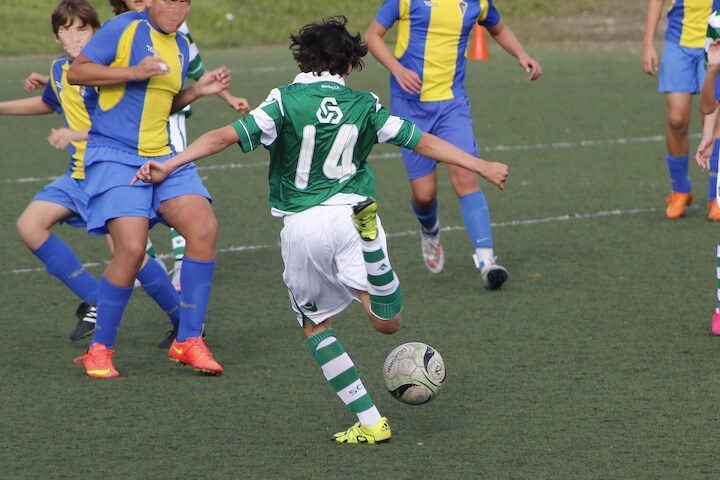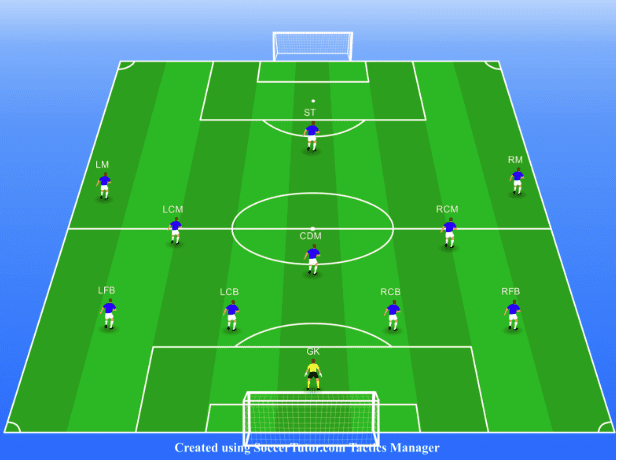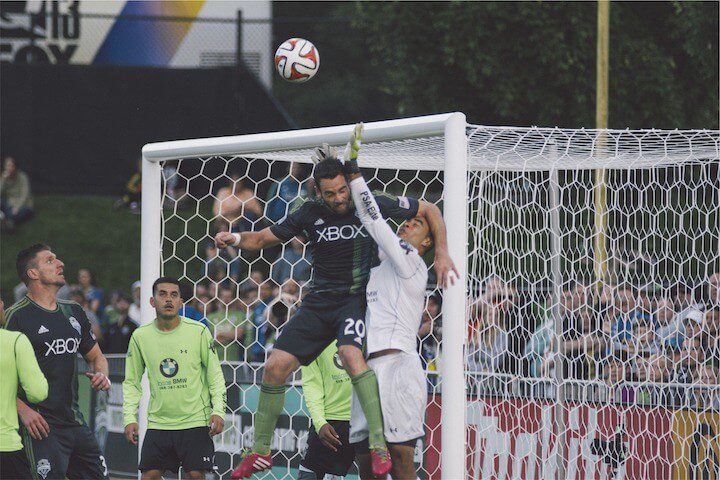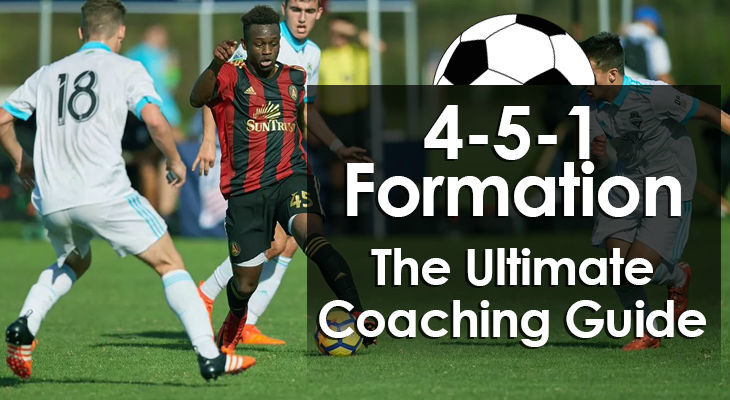4-5-1 Formation – The Ultimate Coaching Guide
The world of soccer tactics is always evolving.
Just as trends and formations begin to dominate, a new strategy emerges, shifting the entire landscape once again.
The 4-5-1 is a shape that's been around for some time but only truly rose to prominence when coaches started looking for alternatives to a 4-4-2.
Rather than play fast-paced, counter-attacking soccer with two strikers up top, most tacticians now prefer a lone striker with more options in midfield.
Thus, the 4-5-1 has become a major player in the modern game.
In reality, however, most teams play a variation, like 4-3-3, 4-2-3-1, or 4-3-2-1.
Nonetheless, the core principles of each of these adaptations come from the 4-5-1.
Today, I discuss the 4-5-1 formation in detail, describing its strengths and weaknesses, before giving you a tactical breakdown on how to successfully implement it.
What is a 4-5-1 Formation?
With a back four and a midfield five, the 4-5-1 is often considered to be very defensive.
And on paper, this might be true.
However, it all depends on how you set up your team and in particular, the center midfielders.
With attack-minded personnel in the midfield trio, you can totally change the emphasis of the shape from all-out defense to a more balanced approach.
Either way, the numbers in midfield and the flat-back four mean this formation provides excellent defensive stability.
You have ample cover in key areas and your opponents should struggle to penetrate through the middle.
In possession, your midfielders and wide players must get forward to create high-percentage chances.
Without gambling occasionally, the striker will likely become isolated and you’ll struggle to score goals.
This further emphasizes the need for offensively capable midfielders in your squad.
Moreover, the attacking shortcomings demonstrate why many coaches opt for specialist midfielders and variations of the strict 4-5-1.
However, as with many formations, you can experience a lot of success with this setup, and with a top striker, you’ll be a nightmare for opponents.

4-5-1 Formation Strengths
#1. Tactical Flexibility
The modern game is all about tactical flexibility and in this regard, the 4-5-1 formation is a winner.
If you watch your favorite team closely, you’ll notice that they probably change their shape when attacking or defending.
For example, in a 4-5-1, teams usually maintain this structure out of possession.
However, when they’re on the ball, the shape may adapt to a 4-2-3-1 or a 4-3-3.
With a 4-5-1, this process is straightforward; it just requires certain players to take up more advanced positions.
By changing the roles of your midfielders, the 4-5-1 can be transformed to suit virtually any strategy.
#2. Various Points of Attack
In most teams, attacking sequences originate in midfield.
Since you have five of them in a 4-5-1, you have points of attack across the width of the field.
You can get the ball wide and swing in crosses or create passing triangles in midfield to progress the ball centrally.
The talent levels of your individual midfielders largely dictate the options you have.
#3. Strong Defensively
With five midfielders sitting in front of a flat-back four, the 4-5-1 formation is difficult to break through.
To boot, with good positioning and defensive discipline, clear goalscoring opportunities should be hard to come by.
When defending a lead, your midfielders can drop back into a mid-block to plug any gaps and minimize space between the lines.
This can be extremely frustrating for opponents who may revert to long ball tactics or long shots.
#4. Seamless Ball Retention
The sheer numbers in defense and midfield also make it easy to keep the ball in a 4-5-1.
There are opportunities to create numerical overloads and passing triangles across the entire pitch allowing for methodical ball progression.
If the opposition squeezes centrally, space opens on the wings, giving you even more offensive opportunities.
#5. Counter Attacking Opportunities
The defensive and midfield banks make it easy for your team to absorb pressure.
While you don’t want to sustain swarms of attacks for long periods, this strategy sets up your team for counterattacks.
As opponents grow frustrated or decide to gamble with more forward players, they are left increasingly vulnerable.
Once you turn the ball over, your wingers should hit the sidelines looking to catch the opposition on the counter.
4-5-1 Formation Weaknesses
#1. Striker May Become Isolated
For all the advantages a 4-5-1 brings, an isolated striker can breed significant problems.
Firstly, if they don’t receive support, they’ll be surrounded and unable to create meaningful chances.
Secondly, if the only help comes from the wingers, your team will lack a central attacking threat.
Thirdly, isolated strikers are likely to become frustrated.
With no significant chances coming their way, they may fall into a slump or lose confidence.
And for any of you strikers out there, you know how important confidence is as the leading attacker.
#2. Tough to Implement a High Press
The natural defensive tactic in a 4-5-1 is to use the midfield and defensive banks to crowd the defensive third.
While this is effective, it makes it difficult to press from the front, which is a hugely popular strategy in the modern game.
If your opponents are comfortable with building attacks methodically, which many of today’s teams are, this can be problematic.
It essentially invites them forward and encourages them to retain possession, limiting your opportunities to create high-percentage chances.
#3. Midfield Can Get Overwhelmed
How you set up your center midfield three is crucial in this formation.
And while there’s no right or wrong way to do it, you need to think about the spaces between the lines (areas between your backline and midfield).
In today’s game, most teams operate with center defensive midfielders (CDMs) and center attacking midfielders (CAM) who take up positions in these areas.
Slick passing and clever movement can allow teams to bypass your midfield, which can get overwhelming.
That’s why most coaches will designate at least one midfielder to take on a more defense-focused role.
#4. Requires Talented Midfielders
Since success in the 4-5-1 relies heavily on the midfield, it’s imperative that you have talented players in these positions.
Your center mids should be well-rounded and capable of their offensive and defensive duties.
In addition to having technical skills, they must be intelligent and positionally aware so they understand the right times to get forward and retreat.
If you don’t have many two-way midfielders in your squad, consider opting for specialist midfielders and refine each of their roles to suit your team.
How to Play the 4-5-1 Formation
The 4-5-1 formation is one that most coaches will think about using.
If you like what you’ve read so far, the next step is to understand how to play in this shape.
So, let’s take a look.
4-5-1 Formation Setup
On paper, this formation is easy to digest.
It consists of:
Flat-back four (two center backs and two fullbacks)
Three center midfielders flanked by two wingers
One striker
On the field, you’ll see that it’s well-balanced, so long as the striker doesn’t get isolated.

Attacking in the 4-5-1 Formation
Generally, the biggest issues in a 4-5-1 formation come in attack.
Specifically, the problems you’re likely to face are creating clear-cut chances and putting the ball in the back of the net.
Pretty important issues to overcome, right?
This is why it’s crucial to have a clear attacking philosophy and strategies to make and execute goalscoring opportunities.
1. Midfield Support
Fortunately, the solution to combating an isolated striker problem is relatively straightforward:
Support from midfield.
When the ball finds its way to the striker, one or two of the center midfielders should push on in support.
One tactic is to come short for give-and-go passes, forcing the defenders to react.
Another option is for a midfielder to make penetrating runs behind the defense, essentially acting as a second striker.
Attacks can be maintained by having your midfielders hold their advanced positions and keep possession in the final third.
2. Double Up On the Wings
Wingers and fullbacks should work in tandem in attack and defense.
In attack, the reasons are twofold.
Firstly, it draws opposition defenders and midfielders to the wings, creating more space for your midfielders and strikers.
The fullback and winger can keep the ball and probe at the defense, buying time for teammates to get into good attacking positions.
Secondly, space to create in a soccer field generally lies on the wings.
Your wingers and fullbacks must work together to get into positions to cross the ball and set up teammates.
When space opens up, they should also look to shoot and get into the penalty box themselves.
3. Switch the Play
Aside from having a trio of center midfielders, the main advantage of playing with a 4-5-1 formation is width.
One of the best ways to create space and 1v1 opportunities is to switch the play often.
This drags the opposition back and forth, slowly wearing them down and pulling them out of shape.
With three center mids, you should have no problem passing the ball across the field quickly.
Defending in the 4-5-1 Formation
Defending in the 4-5-1 formation poses less problems than attacking.
Even so, many teams trip up by dropping too deep.
1. Avoid Sitting Back
With so many defensive recruits, it’s easy to fall back into a deep, low block to defend your lines.
While there’s a time and a place for this (e.g. when defending a lead late in a game), it’s generally not a good practice.
It invites pressure, allows your opponents to hold onto the ball, and prevents your team from dictating the tempo.
And, when you do win the ball back, the deep positions of your midfielders mean you may struggle to keep possession.
In fact, transitions in deep congested areas can get messy and are the most likely cause of mistakes and subsequently, conceding goals.
Furthermore, unless you leave several attackers up the field, counterattacks from a low block are difficult.
2. Utilize a Mid-Block
A mid-block is where you focus on defending in the middle section of the field.
This is a much more favorable strategy in a 4-5-1 as you have numbers across the entire middle third.
The main idea is to congest the area, block passing lanes, and obstruct any meaningful attacks through central channels.
This is far less comfortable for opponents and gives you a better chance of winning the ball in dangerous areas and retaining possession once you do so.
3. Limit Space Between the Lines
As discussed, the linear focus of the backline and midfield means that opponents can find space between the lines.
Therefore, your midfielders must be particularly aware of opposition players drifting into these positions.
It’s typically beneficial for at least one center midfielder to drop off out of possession to give your team a presence between the lines.
Another important factor is to make sure there isn’t a big gap between your midfield and backline.
While the defense doesn’t have to push dangerously high, the less space between both lines, the better.

Individual Position Responsibilities
Goalkeeper
There are two schools of thought when it comes to goalkeeper selection in a 4-5-1 formation.
The first is a modern one.
Over the past decade, there has been a shift in focus on what skillset a goalie should have.
Since most teams now build from the back, goalkeepers are expected to contribute with the ball at their feet.
This offers outfielders an extra passing outlet and gives your team an extra option to beat a high press.
Keepers can play mid-range passes over the pressing forwards to initiate the next phase of play.
The second school of thought is that with enough numbers in defense and midfield, your goalie should excel in shot-stopping and under crosses.
These days, we’re starting to see a new breed of goalkeeper who can do a little bit of everything.
Center Backs
With plenty of defensive coverage in front of them, the role of the center backs (CBs) is quite a traditional one and the message should be to defend first.
They’re called upon to make interceptions and tackles, and to compete for aerial duals, which are all part and parcel of a defender’s job.
The keys to excelling in the CB roles are to have good positional sense and an ability to read the game.
These attributes ensure there are no large gaps between the backline and the midfield and allow the defenders to be proactive rather than reactive.
Another huge responsibility of the CBs is communication.
They must lead from deep, marshaling their fullbacks and instructing their midfielders.
When the midfield drops too deep, the CBs must urge them forward to maintain the team’s shape.
Fullbacks
In comparison to a 4-3-3, the fullbacks in a 4-5-1 should maintain deeper positions.
Their core responsibilities are to mark the opposition winger, defend the wide areas, and govern the back post.
They should be skilled and tenacious defenders and must thrive in 1v1 situations.
This means having discipline and refraining from diving into tackles or making rash defensive decisions.
Out of possession, the fullbacks typically tuck in to be closer to the CBs.
Wingers track back and help out along the flanks.
However, going forward, the fullbacks should stay as wide as possible.
There’s no need to maintain very advanced positions but they should link up with the wingers in attack.
Offensively, fullbacks can keep it simple, using overlapping and underlapping runs to find space in the final third.
Having good delivery skills is a major advantage and gives the team an extra threat around the opposition goal.
Center Midfield Trio
The three central midfielders are perhaps the main reason this formation is considered to be so compact and solid.
They are the team’s engine and have an enormous influence over how the game goes.
There are several ways to set up this trio but in a strict 4-5-1, most coaches use the same approach with two box-to-box players and one more defensive-minded midfielder.
The box-to-box midfielders should support attacks where possible and hold slightly higher positions throughout the game.
While the other can get forward, they must be wary of counterattacks.
In general, there shouldn’t be large gaps between each midfielder ensuring they can form passing triangles to progress the ball.
When defending, their shape should be more linear to block passing lanes and stop central penetration.
It can be easy for a central midfielder to drop deeper and deeper when the opposition has the ball but this should be avoided.
Utilize the mid-block and try to steer the other team away from goal.
While they can’t be rash, your midfielders shouldn’t be passive and must not shy away from a tackle.
If the ball is there to be one, they should press and engage the opponent.
Wingers
Wingers in a 4-5-1 operate slightly deeper than those in modern formations like 4-2-3-1 or 4-3-3.
The main idea of this is to maintain the width in midfield and to add additional cover in defense.
These players are required to have a high work rate since they have important offensive and defensive duties.
Although many wingers today play inverted, maintaining width is essential to stretch the opposition.
Dribbling skills, 1v1 abilities, and efficiency in the final third are the most desirable attributes for your wingers.
Since they’re likely to be afforded the most space in the final third, they must be able to execute.
The mark of a great winger is high efficiency in dangerous areas, whether this means finding the striker with a cross, threading a through pass, or cutting the ball back for onrushing midfielders.
Defensively, discipline is a key factor.
Wingers don’t have to be outstanding defenders but they should be able to hold their own and at least slow down the opposition when they attack.
Striker
For this formation to really work, you need a striker with devastating finishing skills.
But that’s not all.
Operating as the lone attacker, your center forward will be relied upon for holding the ball up, running into the channels, and competing physically with the defenders.
Something that’s not spoken about enough when it comes to strikers is mental fortitude.
Often feeding off scraps, they must remain focused on the task and confident that they will score with the next opportunity.
There is no room for frustration as a sole striker.
In an ideal world, this striker would be a mix between a target man and a mobile striker who can stretch the opposition and get in behind their defense.
While goal poaching is the most important attribute, it’s a major advantage to have a striker who can also facilitate.
Karim Benzema, Robert Lewandowski, and Erling Haaland are perfect examples of strikers who can lead the line solo.
Even when they’re not influencing the game, they remain quietly confident that their next goal is moments away.

How to Beat a 4-5-1 Formation
Beating a 4-5-1 formation is most certainly a puzzle for coaches.
Yet still, there are ways to exploit its weaknesses.
Here are three highly effective tactics to use against this defensively solid shape.
1. Push Them Back with an Attacking Formation
Pinning the team back with an attacking shape, like a 4-3-3 helps create a large gap between the midfield and the striker.
While it may still be difficult to penetrate the defense, isolating the striker limits opportunities for them to create meaningful attacks.
Additionally, matching the midfield trio with three of your own gives you a better shot at winning the midfield battle.
A three-player frontline stretches the defense and forces the midfield to drop deeper.
Although this is a gung-ho approach, it can be highly effective if you commit to it.
2. Play Between the Lines
Perhaps the best way to penetrate the five-player midfield is to make them look over their shoulders constantly.
Rather than match up directly against them, use center attacking midfielders or number 10s to play between the defensive and midfield lines.
This will help pull the midfielders out of position, allowing you to progress the ball.
However, it’s important to note that this strategy requires crafty midfielders who can play line-breaking passes.
3. Use Wingbacks or Attacking Fullbacks
Wingbacks and attacking fullbacks help pin your opponent back and allow your players to maintain positions between the lines.
Again, this is a highly attacking tactic to beat a defensive team.
While your fullbacks should remain high up the field when possible, they mustn’t ignore their defensive responsibilities.
Otherwise, you’ll get caught on the break.
Conclusion
While sustaining attacks in a 4-5-1 formation can be a challenge, it’s by no means impossible.
With correct spacing and willingness to commit players forward in possession, you can find a lot of success in this shape.
And defensively, your team will be hard to get at.
In saying that, there’s a reason most coaches prefer a more staggered midfield with defensive and attacking-focused players.
If you’re struggling for consistency with your five-player midfield, don’t be afraid to switch things up and revert to a 4-3-3, 4-2-3-1, or 4-1-3-2.

